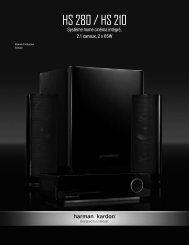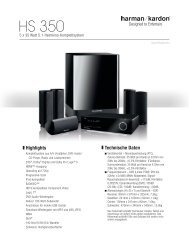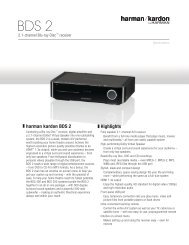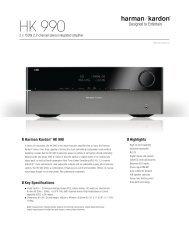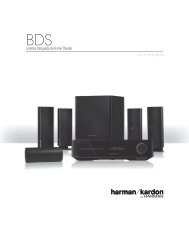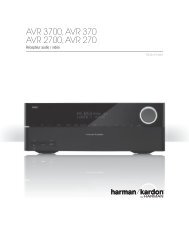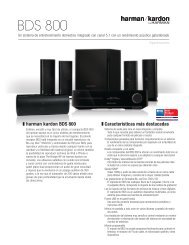music system owner's manual - Harman Kardon
music system owner's manual - Harman Kardon
music system owner's manual - Harman Kardon
You also want an ePaper? Increase the reach of your titles
YUMPU automatically turns print PDFs into web optimized ePapers that Google loves.
anner head<br />
MS 100<br />
MUSIC SYSTEM<br />
OWNER’S MANUAL<br />
1
SAFETY INFORMATION<br />
Important Safety Instructions<br />
1.<br />
2.<br />
3.<br />
4.<br />
5.<br />
6.<br />
Read these instructions.<br />
Keep these instructions.<br />
Heed all warnings.<br />
Follow all instructions.<br />
Do not use this apparatus near water.<br />
Clean only with a dry cloth.<br />
7. Do not block any ventilation openings. Install in accordance with the<br />
manufacturer’s instructions.<br />
8. Do not install near any heat sources such as radiators, heat registers, stoves or<br />
other apparatus (including amplifiers) that produce heat.<br />
9. Do not defeat the safety purpose of the polarized or grounding-type plug. A<br />
polarized plug has two blades with one wider than the other. A grounding-type<br />
plug has two blades and a third grounding prong. The wide blade or the third<br />
prong is provided for your safety. If the provided plug does not fit into your<br />
outlet, consult an electrician for replacement of the obsolete outlet.<br />
10. Protect the power cord from being walked on or pinched, particularly at plugs,<br />
convenience receptacles and the point where they exit from the apparatus.<br />
11. Only use attachments/accessories specified by the manufacturer.<br />
12. Use only with the cart, stand, tripod, bracket or table specified<br />
by the manufacturer or sold with the apparatus. When a cart is<br />
used, use caution when moving the cart/apparatus combination<br />
to avoid injury from tip-over.<br />
13. Unplug this apparatus during lightning storms or when unused for long periods<br />
of time.<br />
14. Refer all servicing to qualified service personnel. Servicing is required when the<br />
apparatus has been damaged in any way, such as power supply cord or plug is<br />
damaged, liquid has been spilled or objects have fallen into the apparatus, the<br />
apparatus has been exposed to rain or moisture, does not operate normally, or<br />
has been dropped.<br />
15. Do not expose this apparatus to dripping or splashing and ensure that no<br />
objects filled with liquids, such as vases, are placed on the apparatus.<br />
16. To completely disconnect this apparatus from the<br />
AC Mains, disconnect the power supply cord plug from the AC receptacle.<br />
17. The mains plug of the power supply cord shall remain readily operable.<br />
18. Do not expose batteries to excessive heat such as<br />
sunshine, fire or the like.<br />
The lightning flash with arrowhead symbol, within an equilateral<br />
triangle, is intended to alert the user to the presence of uninsulated<br />
“dangerous voltage” within the product’s enclosure that may be of<br />
sufficient magnitude to constitute a risk of electric shock to persons.<br />
The exclamation point within an equilateral triangle is intended to<br />
alert the user to the presence of important operating and maintenance<br />
(servicing) instructions in the literature accompanying the product.<br />
WARNING: To reduce the risk of fire or electric shock,<br />
do not expose this apparatus to rain or moisture.<br />
Pb<br />
Instructions for users on removal and disposal of used batteries.<br />
Specification of included battery types.<br />
These symbols shown on the product, the packaging or in the <strong>manual</strong> or separate<br />
information sheet mean that the product itself, as well as the batteries included or<br />
built into the product, should never be thrown away with general household waste.<br />
Take them to applicable collection points, where proper treatment, recycling and<br />
recovery takes place, in accordance with national or local legislation, or European<br />
Directives 2002/96/EC and 2006/66/EC.<br />
Correct handling of the product and batteries to be disposed helps saving resources<br />
and prevents possible negative effects on the environment or human health.<br />
The batteries included with your equipment may be Alkaline, Carbon Zink/<br />
Manganese or Lithium (button cells) type. All types should be disposed of according<br />
to the above instructions.<br />
To remove the batteries from your equipment or remote control, reverse the<br />
procedure described for inserting batteries in the Owners Manual.<br />
For products with a built-in battery that lasts for the lifetime of the product, removal<br />
may not be possible for the user. In this case, recycling or recovery centers handle<br />
the dismantling of the product and the removal of the battery. If, for any reason, it<br />
becomes necessary to replace such a battery, this procedure must be performed by<br />
authorized service centers.<br />
Declaration of Conformity<br />
We, <strong>Harman</strong> Consumer Group, Inc.<br />
2, route de Tours<br />
72500 Château du Loir<br />
France<br />
declare in own responsibility that the product descibed<br />
in this owner’s <strong>manual</strong> is in compliance with technical<br />
standards:<br />
EN 55013:2001+A1:2003<br />
EN 55020:2002+A1:2003<br />
EN 61000-3-2:2000<br />
EN 61000-3-3:1995+A1:2001<br />
EN 60065:2002<br />
Jurjen Amsterdam<br />
<strong>Harman</strong> Consumer Group, Inc.<br />
Château du Loir, France 3/09<br />
2
TABLE OF CONTENTS<br />
2 SAFETY INFORMATION<br />
4 INTRODUCTION AND FEATURES<br />
4 SUPPLIED ACCESSORIES<br />
5 FRONT-PANEL CONTROLS<br />
6 REAR-PANEL CONNECTIONS<br />
7 REMOTE CONTROL FUNCTIONS<br />
9 INSTALLATION<br />
10 OPERATION<br />
10 Using the Remote Control<br />
10 Setting the Clock<br />
10 Turning On the MS 100<br />
10 Setting the Alarm<br />
10 Volume Control<br />
10 Source Selection<br />
10 FM Radio<br />
11 Program Station Presets<br />
11 CD<br />
11 Playback Control<br />
12 Data Discs<br />
12 Auxiliary Inputs<br />
12 Dock for iPod<br />
12 Photo and Video Playback<br />
12 Undocking the iPod<br />
13 Troubleshooting Guide<br />
14 Technical Specifications<br />
14 Trademark Acknowledgements<br />
English<br />
3
STANDBY<br />
PR–<br />
TUNE–<br />
EJECT<br />
MUTE<br />
VOLUME<br />
ON<br />
PR+<br />
TUNE+<br />
INTRODUCTION AND FEATURES<br />
More than 50 years ago, <strong>Harman</strong> <strong>Kardon</strong>, Inc., sold the very first<br />
audio receiver, a high-performance component that combined<br />
the functions of several products that had previously only been<br />
available separately. Our mission was and is to deliver highfidelity<br />
sound in an easy-to-use package, and we are confident<br />
that you will enjoy the quality and convenience of the MS 100<br />
<strong>music</strong> <strong>system</strong> for many years to come.<br />
The MS 100 is a complete high-performance audio <strong>system</strong> with<br />
a CD player, FM tuner, dock for iPod (not included), auxiliary<br />
inputs for other audio products and built-in loudspeakers for<br />
a complete audio solution.<br />
To obtain the maximum enjoyment from your new <strong>system</strong>, we<br />
urge you to read this <strong>manual</strong> and refer back to it to familiarize<br />
yourself with the MS 100’s features and operation.<br />
If you have any questions about this product, its installation or<br />
its operation, please contact your retailer or custom installer,<br />
or visit www.harmankardon.com.<br />
<strong>Harman</strong> <strong>Kardon</strong> ® MS 100 High-Performance Audio System<br />
• Universal dock for iPod (not included) charges iPod touch,<br />
iPod nano 3rd generation, iPod classic, iPod nano 2nd generation,<br />
iPod 5th generation, iPod nano 1st generation, iPod<br />
4th generation, iPod mini; video and still-image playback<br />
requires a compatible iPod that supports video browsing<br />
• Slot-loaded CD player with CD, CD-R, CD-RW, enhanced CD,<br />
MP3 and WMA playback<br />
• FM tuner with RDS text display and six presets<br />
• Four auxiliary audio inputs: front-panel stereo mini-jack<br />
(3.5mm), rear-panel stereo mini-jack (3.5mm) for line-level<br />
or optical-digital audio, rear-panel dual RCA jacks (line-level)<br />
• Two 2-way, 125mm built-in bass-reflex speakers<br />
• Subwoofer output (low-pass filtered)<br />
• Stereo headphone output (3.5mm)<br />
• Composite and S-video outputs for photo- and video-capable<br />
iPod models that support video browsing<br />
• Clock with alarm and memory backup<br />
iPod not included<br />
Supplied Accessories<br />
The following accessory items are supplied with the MS 100.<br />
If any of these items are missing, please contact <strong>Harman</strong><br />
<strong>Kardon</strong> customer service at www.harmankardon.com.<br />
FM wire antenna<br />
Stereo mini-plug<br />
(3.5mm) male-tomale<br />
cable (1m)<br />
Mini (3.5mm)<br />
optical-digital<br />
audio cable (1m)<br />
External power<br />
supply (24V,<br />
5.0 amps) with<br />
detachable<br />
power cord<br />
System remote<br />
control with two<br />
AAA batteries<br />
Detachable dock<br />
for iPod with five<br />
adapters<br />
4
FRONT-PANEL CONTROLS<br />
Message Display: The time and messages are displayed<br />
on top of the unit.<br />
On/Standby: Press to turn the MS 100 on or to place it<br />
in Standby mode. Press and hold for 2 seconds to disarm the<br />
alarm. To completely power off the unit, unplug the power supply.<br />
Source: Each press changes the current source in this order:<br />
FM, CD, AUX LINE IN 1 (rear-panel 3.5mm analog input), AUX<br />
LINE IN 2 (front panel), AUX LINE IN 3 (rear-panel dual RCA<br />
jacks), AUX DIGITAL IN, iPod.<br />
Volume Controls: Increases or decreases the volume.<br />
Press and hold to change the volume more quickly. Press both<br />
together to mute.<br />
Play/Pause/Memory: This button functions differently,<br />
depending on which source has been selected:<br />
• iPod or CD: Each press toggles between the Play and<br />
Pause functions. Press and hold to fully stop playback.<br />
• FM Radio: If the current station has not been programmed<br />
into a preset, the station is stored as a preset. If<br />
all of the preset positions have been used, the new preset<br />
will overwrite the existing one. If the current station has<br />
previously been programmed as a preset, the preset will<br />
be erased after 2 seconds.<br />
Skip/Scan Forward/Reverse: These buttons function<br />
differently, depending on the current source:<br />
• iPod or CD: Press and release to skip to the next track.<br />
Press the reverse button twice to skip to the previous<br />
track. Press and hold to scan forward or reverse within a<br />
track.<br />
• FM Radio: Press and release to tune to the next higher or<br />
lower station by one frequency increment. Press and hold<br />
to scan quickly through the stations. When you release the<br />
button in Auto tuning mode, the tuner continues to scan<br />
until it finds a station of acceptably strong signal quality,<br />
and then it stops. In Manual tuning mode, the tuner stops<br />
immediately at the current frequency.<br />
Headphone Jack: Outputs a stereo signal for private<br />
listening through most headphones that are equipped with<br />
a 3.5mm plug.<br />
AUX-IN Jack (Analog Input 2): Connect the included<br />
3.5mm male-to-male cable to the headphone or line-level<br />
output on a portable player or other device.<br />
CD Slot: Load compatible discs here.<br />
Eject: When a CD is loaded, press this button to eject it.<br />
Dock for iPod: Gently insert the dock into the opening<br />
on the left side of the MS 100, snap in the correct adapter<br />
(or use the one supplied by Apple, Inc., with the iPod) and install<br />
a compatible iPod (see page 4).<br />
English<br />
Message Display<br />
On/Standby<br />
Source<br />
Volume Up<br />
Volume Down<br />
Play/Pause<br />
Dock for iPod (Install Here)<br />
Skip/Scan Forward<br />
Skip/Scan Reverse<br />
Headphone Jack<br />
AUX Line-In 2<br />
CD Slot<br />
Eject<br />
5
REAR-PANEL CONnections<br />
DC Power Input: After making all other connections, plug<br />
in the power supply. Plug the included region-specific power<br />
cord into the power supply and into an unswitched wall outlet.<br />
Analog 1/Optical-Digital Auxiliary Audio Input:<br />
Connect either the stereo mini-plug cable or the optical-digital<br />
audio cable (both cables included) here, and connect the other<br />
end of the cable to a source device, such as a portable CD<br />
player. Connect the stereo mini-plug cable only to the player’s<br />
line-level analog audio output or headphone jack, and connect<br />
the optical cable only to an optical-digital audio output. Select<br />
the Analog 1 or Digital Audio source.<br />
Auxiliary Analog 3 Audio Input: Connect one end<br />
of a two-lead analog audio RCA-type interconnect cable (not<br />
included) here, and connect the other end to the analog-audio<br />
outputs on a source device, such as a tape deck.<br />
Subwoofer Output: Connect this low-pass filtered output<br />
to a powered subwoofer (not included) for improved low-frequency<br />
(bass) reproduction.<br />
Composite and S-Video Outputs: Connect either<br />
of these outputs to a TV or video display for viewing videos or<br />
photos stored on a compatible iPod that supports video browsing.<br />
As of this writing, only the iPod nano 3rd generation, iPod<br />
classic and iPod 5th generation models support video browsing.<br />
No other displays are available through these outputs.<br />
FM Antenna Terminal: Connect the included FM antenna<br />
wire here.<br />
ANTENNA<br />
FM75Ω<br />
FM ANTENNA<br />
TERMINAL<br />
AUX IN<br />
VIDEO OUT<br />
DC IN<br />
24V 5A<br />
120W<br />
ANALOG/<br />
DIGITAL<br />
IN<br />
SUBWOOFER<br />
OUT<br />
S-VIDEO<br />
DC Power Input<br />
ANALOG 1/OPTICAL-<br />
DIGITAL AUXILIARY<br />
AUDIO INPUT<br />
AUXILIARY ANALOG SUBWOOFER<br />
AUDIO INPUT OUTPUT<br />
S-VIDEO<br />
OUTPUT<br />
VIDEO<br />
OUTPUT<br />
6
REMOTE CONTROL FUNCTIONS<br />
Standby: Powers down the MS 100 to Standby mode,<br />
where power is only available to the clock and alarm functions.<br />
To completely power off the unit, unplug the power supply.<br />
Power On: Turns the MS 100 on.<br />
Track-Skip/Scan/Tuning Up/Down: These buttons<br />
function differently, depending on which source has been<br />
selected:<br />
• iPod or CD: Press and release to skip to the next<br />
track. Press the reverse button twice to skip to the previous<br />
track. Press and hold to scan forward or in reverse<br />
within a track.<br />
• FM Radio: See Tuning on this page.<br />
Play/Pause/Memory: This button functions differently,<br />
depending on which source has been selected:<br />
• iPod or CD: Each press toggles between the Play and<br />
Pause functions. Press and hold to fully stop playback.<br />
• FM Radio: If the current station has not been programmed<br />
into a preset, the station is stored as a preset. If all of the<br />
preset positions have been used, the new preset will overwrite<br />
the existing one. If the current station has previously<br />
been programmed as a preset, the preset will be erased after<br />
2 seconds.<br />
Source Select: Each press changes the current source in<br />
this order: FM, CD, AUX LINE IN 1 (rear-panel 3.5mm analog<br />
input), AUX LINE IN 2 (front panel), AUX LINE IN 3 (rear-panel<br />
dual RCA jacks), AUX DIGITAL IN, iPod.<br />
Tuning Mode: Used with FM radio, each press toggles between<br />
Auto and Manual tuning.<br />
Playback Mode: Used only for iPod or CD playback, each<br />
press changes the repeat and random (shuffle) playback mode.<br />
See page 12 for the modes available with each source. When<br />
the MS 100 is turned off or when the source is changed, the<br />
playback mode returns to Normal.<br />
Sleep: Each press increases the time until turn-off, from 10<br />
to 90 minutes, in increments of 10 minutes. The next press<br />
after the 90 minutes setting turns off the Sleep function.<br />
Clock Adjust Mode: With the MS 100 in Standby mode,<br />
press this button to adjust the clock. Use the / Navigation<br />
Buttons to adjust the hour, minute and 12/24 settings. To<br />
change between AM and PM, increase or decrease the hour.<br />
Press the / Buttons to move the cursor to the previous or<br />
next position. Press this button again at any time when finished.<br />
Alarm Adjust Mode: With the MS 100 in Standby mode,<br />
press this button to adjust the alarm. Use the / Navigation<br />
Buttons to adjust the hour, minute and wake-up source settings.<br />
To change between AM and PM, increase or decrease the hour.<br />
Press the / Buttons to move the cursor to the previous or<br />
next position. Press this button again at any time when finished.<br />
Preset Search: Used for FM radio to select the next or<br />
previous preset station, if any have been programmed.<br />
Eject: When a CD is loaded, press this button to eject it.<br />
Tuning: Used for FM radio. Press and release to tune to<br />
the next higher or lower station by one frequency increment.<br />
Press and hold to scan quickly through the stations. When you<br />
release the button, if Auto tuning mode is active, the tuner<br />
continues to scan until it finds a station of acceptably strong<br />
signal quality, and then it stops. In Manual tuning mode, the<br />
tuner stops immediately at the current frequency.<br />
/ / / Navigation Buttons: Used with the iPod to<br />
navigate its menus, or in Standby mode to adjust the clock<br />
or alarm. The / Buttons are used for scrolling. Press the<br />
Button to select the current item, and the Button to display<br />
the menu or return to the previous menu screen.<br />
Mute: Press to temporarily silence the speakers. Press again<br />
to restore audio. Muting is canceled if the MS 100 is turned off.<br />
Volume Controls: Increases or decreases the volume.<br />
Press and hold either button to change the volume more quickly.<br />
English<br />
7
REMOTE CONTROL FUNCTIONS<br />
STANDBY<br />
ON<br />
Standby<br />
Power On<br />
Play/Pause/Memory<br />
Tuning Mode<br />
Source Select<br />
Clock Adjust<br />
Sleep<br />
SOURCE TUNE PLAYBACK<br />
SLEEP CLOCK ADJ ALARM ADJ<br />
PR– EJECT PR+<br />
Track-skip/Scan/<br />
Tuning Up/Down<br />
Playback Mode<br />
Alarm Adjust Mode<br />
Eject<br />
Preset Search<br />
TUNE–<br />
TUNE+<br />
Tuning<br />
MUTE<br />
/ / Navigation<br />
Mute<br />
Volume Controls<br />
VOLUME<br />
8
INSTALLATION<br />
1. Carefully unpack the MS 100, the FM antenna, the analog<br />
and digital audio cables, the power supply and detachable<br />
cable, the dock for iPod and inserts, and the remote control<br />
and batteries.<br />
2. Install the batteries in the remote control, following the “+”<br />
and “–” symbols in the battery compartment to maintain<br />
the correct polarity.<br />
Caution: Danger of a explosion if battery is incorrectly<br />
replaced. Replace only with the same or equivalent type.<br />
3. Connect the FM antenna to its terminal.<br />
4. Plug the detachable dock for iPod into the connector on<br />
the left side of the MS 100.<br />
5. The MS 100 features four audio inputs for other devices,<br />
such as portable players. This step is optional, and may be<br />
skipped if you have no external devices. If your player has:<br />
• 3.5mm Analog audio output or headphone jack:<br />
Plug included analog audio cable into the output or headphone<br />
jack and either the front- or rear-panel mini-jack on<br />
the MS 100. Both inputs may be used simultaneously for<br />
different devices. A second cable must be purchased.<br />
• Pair of RCA-type analog audio outputs: Plug one<br />
end of a two-conductor interconnect cable (not included)<br />
into the player, and the other end into the Auxiliary Input<br />
jacks on the rear-panel of the MS 100. Use the same color<br />
connector for each channel (usually red for right and white<br />
or black for left).<br />
• Optical-digital audio S/P-DIF output: Plug one end<br />
of the included digital audio cable into the player, and the<br />
other end into the Analog/Optical Input on the rear panel<br />
of the MS 100. Remember to select the digital input as<br />
the source.<br />
6. If you have purchased an optional powered subwoofer that<br />
is equipped with a line-level input, connect it to the<br />
Subwoofer Output (cable not included). The Subwoofer<br />
Output is filtered, and only passes low-frequency signals. Do<br />
not connect this output to full-range speakers.<br />
7. If you will be viewing photos or videos stored on a compatible<br />
iPod that supports video browsing, connect either the<br />
Composite or S-Video Output (but not both) to a display<br />
monitor.<br />
8. Plug all power cords into unswitched AC outlets.<br />
English<br />
Snap in the adapter that matches your iPod, referring to the<br />
table below.<br />
Adapter<br />
iPod Model<br />
NANO<br />
iPod nano, 1st and 2nd generations<br />
5G (VIDEO 60GB) iPod, 5th generation (60GB, 80GB) and iPod classic (160GB)<br />
5G (VIDEO 30GB) iPod, 5th generation (30GB) and iPod classic (80GB)<br />
13 iPod nano, 3rd generation<br />
12, 14 iPod touch – install large bumper<br />
To remove an adapter, insert a<br />
flathead screwdriver into the slot at<br />
the rear of the adapter and pry it up.<br />
9
STANDBY<br />
MUTE<br />
ON<br />
SOURCE TUNE PLAY BACK<br />
SLEEP CLOCK ADJ ALARM ADJ<br />
PR–<br />
TUNE–<br />
EJECT<br />
VOLUME<br />
PR+<br />
TUNE+<br />
OPERATION<br />
Using the MS 100 is simple and intuitive.<br />
Using the Remote Control<br />
Point the remote at the front of the MS 100. The remote IR<br />
sensor is located in the middle of the front panel, behind the<br />
mesh grille, about 25mm above the CD slot. Do not block the<br />
sensor. The remote has a range of approximately 6m, up to<br />
30 degrees off center. If the batteries require replacement, see<br />
Step 2 of the Installation section. Use caution and dispose of<br />
batteries according to environmental requirements. Never throw<br />
the batteries into fire, and remove them from the remote if it<br />
will be unused for a long period of time.<br />
decrease the hour setting. Use the / Buttons to move the<br />
cursor to the previous or next setting. To arm the alarm, use<br />
the / Buttons to change the Alarm message to “Alarm On”,<br />
and press the Alarm Adjust Mode Button again when you are<br />
finished. The Timer indicator will appear in the Message Display<br />
when the alarm has been set. See Figure 2.<br />
At the set time, the MS 100 will automatically turn on and begin<br />
playing the selected source. If CD or iPod was selected and<br />
there is no disc loaded or iPod docked, the MS 100 will switch<br />
to the FM radio source.<br />
Play will begin at volume level 8, and steadily increase to a<br />
volume level of 20 within 3 minutes. It will continue to play<br />
at level 20 for 45 minutes, and then shut off automatically.<br />
Press any key to place the unit in Snooze mode. It will remain<br />
off for 9 minutes, then the alarm will resume.<br />
Setting the Clock<br />
30º 30º<br />
Before turning the unit on, set the clock: Press the Clock Adjust<br />
Mode Button on the remote, and use the / buttons to set the<br />
correct hour and minute settings when they flash. To change<br />
between AM and PM, increase or decrease the hour setting. Use<br />
the / Buttons to move the cursor to the previous or next<br />
position, and press the Clock Adjust Mode Button again when<br />
you are finished. See Figure 1.<br />
Turning On the MS 100<br />
To turn on the MS 100, press the Power On Button on the<br />
remote, or press the On/Standby Button on the main unit.<br />
The FM Radio will begin to play.<br />
Setting the Alarm<br />
For automatic turn-on at a programmed time, set the alarm.<br />
First, press the Standby Button to turn the unit off; the alarm<br />
may not be set while the unit is on.<br />
Press the Alarm Adjust Mode Button on the remote, and use<br />
the / Buttons to set the alarm time (hour and minute settings)<br />
and alarm source (FM radio, CD player, iPod in dock)<br />
as they flash. To change between AM and PM, increase or<br />
Press and hold the Standby Button while the alarm is playing<br />
to turn it off and return to normal play.<br />
Volume Control<br />
Use the front-panel or remote Volume Controls to raise or lower<br />
the volume. The default setting at turn-on is 8, and the maximum<br />
setting is 30. Use caution with volume levels to avoid<br />
damage to your hearing or equipment. The volume level appears<br />
in the Message Display when the Volume Controls are used.<br />
To temporarily silence playback, press the Mute Button on the<br />
remote, or simultaneously press the front-panel Volume Up and<br />
Down Buttons. “Mute” will flash in the Message Display. Press<br />
the Mute Button or either Volume Control to resume normal<br />
volume. Source playback will continue during muting.<br />
Source Selection<br />
The first time the MS 100 is turned on, it will default to FM<br />
Radio. Each press of the Source Selector switches to the next<br />
source in this order: FM, CD, AUX LINE IN 1 (rear-panel 3.5mm<br />
analog input), AUX LINE IN 2 (front panel), AUX LINE IN 3 (rearpanel<br />
dual RCA jacks), AUX DIGITAL IN, iPod.<br />
Subsequently, the MS 100 will select the last source used<br />
before turn-off.<br />
FM Radio<br />
Press the Tuning Mode Button to select Automatic or Manual<br />
tuning. The AUTO indicator appears when Auto tuning is active.<br />
In Auto tuning mode, pressing the Tuning Up or Down controls<br />
causes the tuner to scan in the selected direction for a signal<br />
with acceptable strength, then stop. The tuner will also stop if<br />
you press the Tuning controls.<br />
In Manual tuning mode, each press of the Tuning Up or Down<br />
controls causes the tuner to move to the next frequency in the<br />
selected direction.<br />
10
Start<br />
Figure 1: Setting the Clock<br />
Start<br />
Right<br />
1 1 : 0 2 A M 1 1 : 0 2 A M 1 1 : 0 2 A M<br />
C L O C K<br />
C L O C K<br />
C L O C K<br />
Right<br />
1 1 : 0 2 A M 1 1 : 0 2 A M 1 1 : 0 2 A M<br />
C L O C K<br />
C L O C K<br />
Right<br />
Left<br />
Left<br />
Right<br />
Left Right<br />
Left<br />
OPERATION<br />
Right<br />
C L O C K<br />
Left<br />
1 1 : 0 2 A M<br />
English<br />
Figure 2: Setting the Alarm<br />
Left<br />
Right<br />
Left<br />
C L O C K<br />
MON D A Y<br />
Right<br />
Left<br />
1 1 : 0 2 A M<br />
C L O C K<br />
MON D A Y<br />
Start<br />
Start<br />
Right<br />
TIMER FM TIMER FM TIMER FM<br />
1 1 : 0 2 A M 1 1 : 0 2 A M 1 1 : 0 2 A M<br />
A L A R M A L A R M A L A R M<br />
Left<br />
Right<br />
TIMER FM TIMER FM TIMER FM<br />
1 1 : 0 2 A M 1 1 : 0 2 A M 1 1 : 0 2 A M<br />
A L A R M A L A R M A L A R M<br />
Left<br />
Right<br />
Right<br />
Left<br />
Right<br />
Left<br />
Right<br />
Left<br />
TIMER<br />
FM<br />
1 1 : 0 2 A M<br />
Left<br />
Right<br />
Right<br />
A L A R M<br />
Left<br />
TIMER<br />
FM<br />
1 1 : 0 2 A M<br />
If a stereo signal is detected, the STEREO indicator will light.<br />
Monaural stations, or weak stereo stations, will be played in<br />
mono (one channel).<br />
If the station is broadcasting RDS information, it will be displayed.<br />
The second line of the Message Display may show the<br />
station's call letters, a name, the Program Type (PTY), or other<br />
information, depending on what the station broadcasts. The<br />
third line indicates the Radio Text (RT) when broadcast. When<br />
no RDS information is available, only the frequency will be displayed.<br />
Program Station Presets<br />
To program a preset for quick access to favorite stations, tune<br />
to the station’s frequency and press and hold the Play/Pause/<br />
Memory Button for 2 seconds. The P01 preset will appear. If no<br />
station has been programmed into the preset, the current station<br />
will be stored.<br />
If a different station was previously programmed, it will be<br />
overwritten by the new station. To select a new preset, use the<br />
Preset Up/Down Buttons; six presets are available. If all six have<br />
been programmed, you must overwrite or erase one to program<br />
a new station preset.<br />
If the current station was stored in the preset position, the<br />
preset will be erased.<br />
NOTE: To cancel programming or erasing of a preset, press<br />
any other key.<br />
To select a preset station, use the PR +/– Buttons.<br />
Left<br />
A L A R M<br />
CD<br />
First press the Eject Button to ensure that no disc is already<br />
present. Then gently insert a CD, CD-R, CD-RW, enhanced CD,<br />
MP3 or WMA disc, label-side up, partway into the slot loader.<br />
The mechanism will detect the disc and pull it the rest of the<br />
way in. Do not attempt to force the disc. If the disc will not<br />
load, turn off the MS 100, unplug it and bring it to an authorized<br />
<strong>Harman</strong> <strong>Kardon</strong> service center for inspection.<br />
If another source is playing, the MS 100 will not automatically<br />
switch to the CD. Press the Source Selector repeatedly until<br />
“CD” is selected.<br />
The “Reading” message will appear for a few moments while<br />
the MS 100 identifies the disc type. The correct indicator will<br />
appear in the Message Display.<br />
NOTE: If the “Error” message appears, the disc is not compatible<br />
with the MS 100, or its data may be damaged. Press the<br />
Eject Button to remove it.<br />
In normal operation, the disc will automatically begin playing.<br />
The Play icon will appear, along with the current and total track<br />
numbers and the elapsed track time. When the disc has finished<br />
playing, the Stop icon will appear, with the total number of<br />
tracks and total disc time.<br />
Playback Control<br />
To momentarily pause playback for later resumption at the<br />
same point, press the Play/Pause Button. Press it again to<br />
resume play. The Pause icon will be displayed. Press and hold<br />
the Play/Pause Button for 2 seconds to fully stop playback.<br />
11
OPERATION<br />
• To search at 4x speed through the current track, press and<br />
hold the Skip/Scan Forward or Skip/Scan Reverse Button.<br />
When the track’s beginning or end is reached,<br />
normal play will begin.<br />
• To skip to the next track, tap the Skip/Scan Forward Button.<br />
If the current track is the last one on the disc,<br />
the MS 100 will skip to the first track.<br />
• To return to the beginning of the current track, tap the Skip/<br />
Scan Reverse Button. Tap it twice quickly to skip backwards<br />
to the previous track.<br />
• For repeat or random (shuffle) play, press the Playback Mode<br />
Button. Each press changes the playback mode<br />
as follows: Repeat 1 Track, Repeat All Tracks, Shuffle,<br />
Shuffle with Repeat All and Normal Playback.<br />
Data Discs<br />
JPEG discs are not compatible with the MS 100, and the display<br />
will indicate that they have no files and no folders.<br />
When an MP3 or WMA disc is loaded, the disc type indicator<br />
will light up, and the number of folders and tracks in the current<br />
folder will be displayed, up to a limit of 999 tracks. Play will<br />
begin automatically. If the disc has both MP3 and WMA tracks,<br />
both indicators will light.<br />
For MP3 discs, the track name and artist will alternate in<br />
the display. For WMA discs, the album and track number will<br />
alternate in the display.<br />
For both disc types, the Skip and Scan functions and Repeat<br />
and Random play are the same as for audio CDs.<br />
Auxiliary Inputs<br />
The MS 100 is equipped with three analog audio inputs and one digital<br />
audio input. If you have connected a compatible device, such as<br />
a portable audio player or a cassette deck, select the corresponding<br />
auxiliary input as the source and use the device’s own controls.<br />
• AUX LINE IN 1 (Analog): rear-panel 3.5mm jack,<br />
shared with Digital Input<br />
• AUX LINE IN 2 (Analog): front-panel 3.5mm jack<br />
• AUX LINE IN 3 (Analog): dual rear-panel RCA-type jacks<br />
• DIGITAL LINE IN: rear-panel 3.5mm jack<br />
Dock for iPod<br />
The MS 100 dock is compatible with most docking iPod models,<br />
4G and later (see page 4). Photos and videos may be viewed<br />
with compatible iPod models that support video browsing, at<br />
this time limited to the iPod nano 3rd generation, iPod classic<br />
and iPod 5th generation.<br />
Install the detachable dock and appropriate adapter as<br />
described in the Installation section, then dock the iPod. Use<br />
the Source Selector to select the iPod source.<br />
Playback will begin automatically with the first track stored<br />
on the iPod.<br />
The transport controls work as they do for CDs:<br />
• To pause or restart play, press the Play/Pause Button.<br />
• To search forward or reverse through a track, press and<br />
hold the Skip/Scan Forward or Reverse Button.<br />
• To skip forward or reverse through the tracks, tap the<br />
Skip/Scan Forward or Reverse Button.<br />
Repeat and Random Play are available. Each press of the<br />
Playback Mode Button switches the mode as follows: Repeat 1<br />
Track, Repeat All Tracks (in the current playlist), Shuffle Albums,<br />
Shuffle Albums with Repeat All, Shuffle Tracks, Shuffle Tracks<br />
with Repeat All, and Normal Play.<br />
To navigate the menus on the iPod:<br />
• Press the Button to display the menu or return to the<br />
previous menu level.<br />
• Press the Button to select the current item.<br />
• Press the / Buttons to scroll up or down.<br />
During play, the current track and total number of tracks in the<br />
current playlist will display alternately with the elapsed and total<br />
times. If available, the artist and track name will also appear.<br />
Photo and Video Playback<br />
If the iPod supports video browsing, navigate its menu <strong>system</strong><br />
to select a video for viewing on a TV connected to one of the<br />
MS 100’s video outputs. Make sure the TV Out setting on the<br />
iPod is turned on. Press the Button, and the video will begin<br />
playing.<br />
To view photos, navigate to the desired library or image and<br />
press the › Button three times. After a few moments, a slideshow<br />
of the images in the selected library will appear<br />
on the TV.<br />
Undocking the iPod<br />
Undock the iPod at any time, as long as playback has been<br />
stopped.<br />
To remove the dock adapter, e.g., to switch adapters for a<br />
different iPod model, insert a flathead screwdriver into the slot<br />
at the rear of the adapter and pry it up. Refer to the illustration<br />
in the Installation section.<br />
12
TROUBLESHOOTING<br />
TroubleShootIng Guide<br />
SYMPTOM<br />
Unit does not function when Power On Switch is<br />
pushed.<br />
SOLUTION<br />
• Make sure the AC power cord is securely plugged into an unswitched<br />
outlet. If the “PROTECT” message appears, turn off the MS 100 and unplug it.<br />
Do not use it without first bringing it to an authorized <strong>Harman</strong> <strong>Kardon</strong> service<br />
center for inspection.<br />
English<br />
Display lights, but there’s no sound.<br />
• Press the Mute Button to make sure the <strong>system</strong> is not muted.<br />
• Turn up the volume.<br />
• Check that the correct source was selected. If the source is an<br />
external device, make sure it is plugged in, turned on and playing,<br />
and that it is properly connected to one of the auxiliary inputs.<br />
• If the headphones are in use, unplug them.<br />
There is sound on only one side, or the sound is<br />
distorted.<br />
• There may be a problem with one of the built-in speakers. Bring the MS 100 to<br />
an authorized <strong>Harman</strong> <strong>Kardon</strong> service center for inspection and service.<br />
The MS 100 does not respond to remote commands.<br />
The tuner is buzzing intermittently.<br />
No video image.<br />
• The batteries in the remote control may require replacement.<br />
• The IR sensor may be blocked. The sensor is located in the middle<br />
of the front grille, about 25mm above the CD slot.<br />
• Adjust the placement of the antenna to improve reception.<br />
• Check that the antenna is securely connected to the rear-panel<br />
terminal.<br />
• Check that the TV is securely connected to either the S-Video or Composite<br />
Video Output, but not both.<br />
• Video is only available when the dock for the iPod has been selected as the<br />
source, and then only when a compatible iPod model that is capable of video<br />
browsing is docked.<br />
• The TV Out setting on the iPod must be turned on.<br />
• There must be photo or video content stored on the iPod.<br />
• Select the correct video input on the TV.<br />
• To view photos, press the<br />
Button three times.<br />
13
MS 100 TECHNICAL SPECIFICATIONS<br />
System:<br />
Power output: 30 watts per channel, 20Hz – 20kHz,<br />
THD < 0.07%, into 6 ohms, both channels driven<br />
Bandwidth: 57Hz – 27kHz, – 6dB<br />
System frequency response: 65Hz – 20kHz, ±3dB<br />
Signal-to-noise ratio, A-weighted: 75dB<br />
Channel separation: > – 60dB<br />
Crosstalk between sources: < – 60dB<br />
Line-level input sensitivity at 1kHz: 1.0V RMS, ±1dB<br />
Loudspeakers:<br />
Low-frequency transducers: Two 125mm felted-paper<br />
drivers, ported<br />
High-frequency transducers: Two 19mm titaniumlaminate<br />
domes<br />
Nominal impedance: 6 ohms<br />
Sensitivity (2.83V/1m): 87dB<br />
Frequency response: 80Hz – 20kHz (±3dB)<br />
FM Tuner Section:<br />
Frequency range: 87.5 – 108.0MHz<br />
Usable sensitivity: IHF 1.3µV/13.2dBf<br />
Signal-to-noise ratio: mono/stereo 70/65dB<br />
Distortion: mono/stereo 0.15/0.3%<br />
Stereo separation: 35dB @ 1kHz, 100% deviation @ 65dBf<br />
Selectivity: ±300kHz: 65dB<br />
Image rejection: 80dB<br />
IF rejection: 90dB<br />
Tuner output level: 1kHz, ±50kHz, Dev 500mV<br />
Number of presets: six<br />
RDS capability: PTY (program type), PS (program service),<br />
Text (radio text)<br />
CD Section:<br />
Disc compatibility: CD, CD-R, CD-RW, enhanced CD, MP3, WMA<br />
THD+N (20Hz – 20kHz): – 65dB<br />
Signal-to-noise ratio:<br />
• “A” WTG >100dBr<br />
• 22kHz filter > 100dBr<br />
Video Outputs:<br />
Composite video: 1.0V (pk-pk), 75 Ω, negative sync<br />
S-video:<br />
(Y) 1.0V (pk-pk), 75 Ω, negative sync<br />
(C) 0.286V (pk-pk), 75 Ω<br />
General:<br />
Power requirement: DC 24V, 5A power supply;<br />
works for AC 230V/50Hz<br />
Power consumption:
15<br />
English
anner head<br />
250 Crossways Park Drive, Woodbury, New York 11797<br />
www.harmankardon.com<br />
© 2009 <strong>Harman</strong> International Industries, Incorporated.<br />
All rights reserved.<br />
Part No. 950-0246-003 Rev. E 3/09<br />
16



